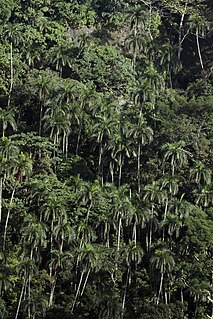
The Nicobar pigeon is a pigeon found on small islands and in coastal regions from the Andaman and Nicobar Islands, India, east through the Malay Archipelago, to the Solomons and Palau. It is the only living member of the genus Caloenas and the closest living relative of the extinct dodo, and extinct Rodrigues solitaire.

Bentinckia is a genus of palms in the Arecaceae family. The genus is named after William Henry Cavendish-Bentinck a colonial governor general of British India. There are two species of palms in this genus namely Bentinckia condapanna and Bentinckia nicobarica.

Bentinckia nicobarica is a species of flowering plant in the Arecaceae family found to occur in the Nicobar group of islands in the Bay of Bengal. This is an endemic Palm occurring in Great Nicobar, Katchal, Nancowry and Car Nicobar Islands.The occurrence of this species in Andaman and Nicobar group of islands other than Katchal Island is yet to be confirmed as natural/escape or by human introduction. It is an endangered species according to IUCN Red List of Threatened Species, 2016 with Red List Category & Criteria as C2a ver 2.3. Living specimens of this taxon is conserving at Indian Botanic Garden, Howrah and at the Field Gene Bank of Jawaharlal Nehru Tropical Botanic Garden and Research Institute, Thiruvananthapuram in India.

The Nicobar treeshrew is a treeshrew species within the Tupaiidae. It is endemic to the Nicobar Islands where it inhabits the islands' rain forests. It is threatened by habitat loss.

The Nicobar shrew or Nicobar white-tailed shrew is a critically endangered species of mammal in the family Soricidae. It is endemic to the Great Nicobar Island of India.
Mangifera nicobarica is a species of plants in the family Anacardiaceae. It is endemic to the Nicobar Islands.

Cethosia biblis, the red lacewing, is a species of heliconiine butterfly belonging to the family Nymphalidae.
Phacusa was a city in the late Roman province of Augustamnica Prima. It served as a bishopric that was a suffragan of Pelusium, the metropolitan see of that province.
Phacusa chalcobasis is a moth of the family Zygaenidae. It was described by George Hampson in 1919. It is found on Sumatra in Indonesia.
Phacusa manilensis is a moth of the family Zygaenidae. It was described by George Hampson in 1919. It is found on Luzon in the Philippines.
Phacusa paracybele is a moth of the family Zygaenidae. It was described by Alberti in 1954. It is found in China.
Phacusa tonkinensis is a moth of the family Zygaenidae. It was described by Alberti in 1954. It is found in Vietnam.
Phacusa birmana is a moth of the family Zygaenidae. It was described by Oberthür in 1894. It is found in Myanmar.
Phacusa discoidalis is a moth of the family Zygaenidae. It was described by Swinhoe in 1903. It is found in northern Vietnam.
Phacusa dolosa is a moth of the family Zygaenidae. It was described by Francis Walker in 1856. It is found in India and Myanmar.
Phacusa inermis is a moth of the family Zygaenidae. It was described by Alberti in 1954. It is found in China.
Phacusa khasiana is a moth of the family Zygaenidae. It was described by Moore in 1879. It is found in India (Assam).
Phacusa properta is a moth of the family Zygaenidae. It was described by Swinhoe in 1890. It is found in Birma, northern India and the Nicobar Islands.
Phacusa subtilis is a moth of the family Zygaenidae. It was described by Hering in 1925. It is found on Java.
Phacusa tenebrosa is a moth of the family Zygaenidae. It was described by Francis Walker in 1854. It is found in northern India.







